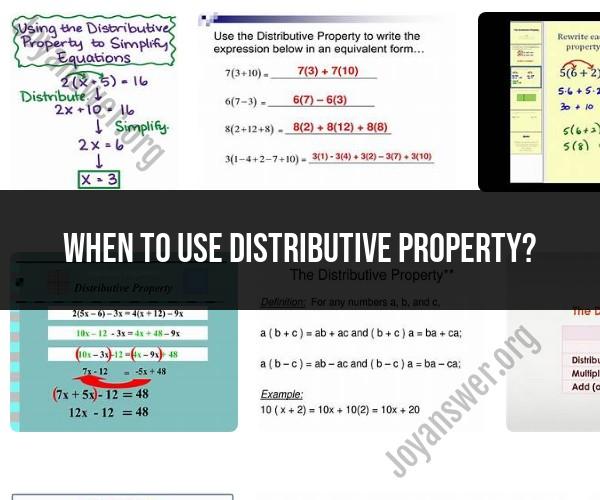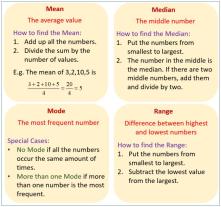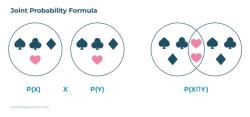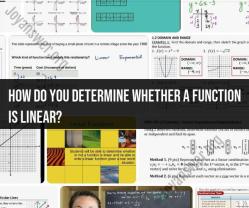When to use distributive property?
The distributive property is a fundamental concept in mathematics that has practical applications in various real-life scenarios. Here are some practical situations and examples of when to use the distributive property:
Distributing Costs in Business:
- Imagine you have a business with multiple locations, and you need to distribute the total monthly costs evenly. If the total cost is represented by (a + b + c) and you have "n" locations, you can use the distributive property to calculate the cost per location as (a/n + b/n + c/n).
Calculating Total Cost:
- Suppose you are purchasing several items at different prices and quantities. You can use the distributive property to calculate the total cost. For example, if you're buying apples at $2 each and bananas at $1 each, you can use the distributive property to find the total cost as 3 * ($2 + $1) = 3 * $2 + 3 * $1 = $6 + $3 = $9.
Factoring Expressions:
- Factoring is an important application of the distributive property. It's used to break down expressions into simpler components. For example, when factoring the expression 2x + 4y, you can use the distributive property to factor out the common factor 2: 2(x + 2y).
Simplifying Algebraic Expressions:
- When simplifying algebraic expressions, the distributive property is often used to remove parentheses. For example, you can simplify the expression 3(x + 2) as 3x + 6 by distributing the 3.
Expanding Algebraic Expressions:
- In algebra, you may need to expand expressions to make calculations or solve equations. For instance, to expand (a + b)(c + d), you would use the distributive property to obtain ac + ad + bc + bd.
Solving Equations:
- When solving equations, the distributive property is used to isolate variables and simplify expressions. For example, in the equation 2(x + 3) = 14, you can use the distributive property to get 2x + 6 = 14, making it easier to solve for x.
Area and Perimeter Calculations:
- When calculating the area or perimeter of geometric shapes, the distributive property can be applied. For instance, when finding the area of a rectangle with sides (a + b) and c, you can distribute the multiplication to get ac + bc.
Budgeting and Financial Planning:
- In personal finance, you might distribute your income among different expense categories, such as housing, groceries, and entertainment. The distributive property helps you calculate the total expense in each category or create a budget.
Resource Allocation:
- In scenarios where resources need to be allocated among different projects or departments, the distributive property can be used to distribute resources proportionally based on predefined percentages or factors.
Probability Calculations:
- In probability and statistics, the distributive property can be applied to determine the probability of compound events or the total probability of different outcomes.
In essence, the distributive property is a versatile mathematical concept that is used whenever you need to distribute, factor, simplify, expand, or manipulate expressions and equations in mathematics, business, finance, science, and various other fields. Understanding how and when to apply the distributive property is a valuable skill for problem-solving and critical thinking.
When should you use the distributive property in mathematics?
You should use the distributive property in mathematics when it can help you to simplify an expression or solve a problem more easily. For example, you can use the distributive property to:
- Simplify expressions involving addition and multiplication
- Solve multiplication problems involving addition
- Solve real-world problems involving addition and multiplication
What are the situations or mathematical problems that require applying the distributive property?
Here are some situations or mathematical problems that require applying the distributive property:
- Simplifying expressions: The distributive property can be used to simplify expressions such as the following:
5(2 + 3) = 5(2) + 5(3)
- Solving multiplication problems: The distributive property can be used to solve multiplication problems such as the following:
How many apples are in 5 bags of 3 apples each?
To solve this problem, we can use the distributive property to write the following equation:
5(3) = 3 + 3 + 3 + 3 + 3
- Solving real-world problems: The distributive property can be used to solve many real-world problems, such as the following:
If a dozen eggs costs $3, what is the cost of 5 dozen eggs?
To solve this problem, we can use the distributive property to write the following equation:
5($3) = 3 + 3 + 3 + 3 + 3
Can you provide guidelines for recognizing opportunities to use the distributive property?
Here are some guidelines for recognizing opportunities to use the distributive property:
- Look for expressions that involve multiplication and addition. For example, the expression is a good opportunity to use the distributive property.
- Look for multiplication problems that involve addition. For example, the problem "How many apples are in 5 bags of 3 apples each?" is a good opportunity to use the distributive property.
- Look for real-world problems that involve addition and multiplication. For example, the problem "If a dozen eggs costs $3, what is the cost of 5 dozen eggs?" is a good opportunity to use the distributive property.
How to choose between different mathematical techniques, including the distributive property?
When choosing between different mathematical techniques, including the distributive property, you should consider the following factors:
- Which technique is the most efficient? The distributive property is often the most efficient technique for simplifying expressions and solving problems involving addition and multiplication.
- Which technique is the easiest for you to use? If you are more comfortable using a different technique, such as factoring, then you can use that technique instead.
- Which technique is the most appropriate for the problem you are trying to solve? Some problems may be better suited for certain techniques than others. For example, if you are trying to simplify a polynomial, you may want to use factoring instead of the distributive property.
How to enhance problem-solving skills by understanding when to use the distributive property?
Understanding when to use the distributive property can enhance your problem-solving skills in the following ways:
- It can help you to identify the most efficient way to solve a problem.
- It can help you to solve problems that involve addition and multiplication more easily.
- It can help you to develop a deeper understanding of mathematics.
Here are some tips for enhancing your problem-solving skills by understanding when to use the distributive property:
- Practice using the distributive property to solve a variety of problems.
- Pay attention to the problems that you are solving and look for opportunities to use the distributive property.
- If you are stuck on a problem, try using the distributive property to see if it can help you to solve it.
By understanding when to use the distributive property, you can enhance your problem-solving skills and become a better mathematician.












